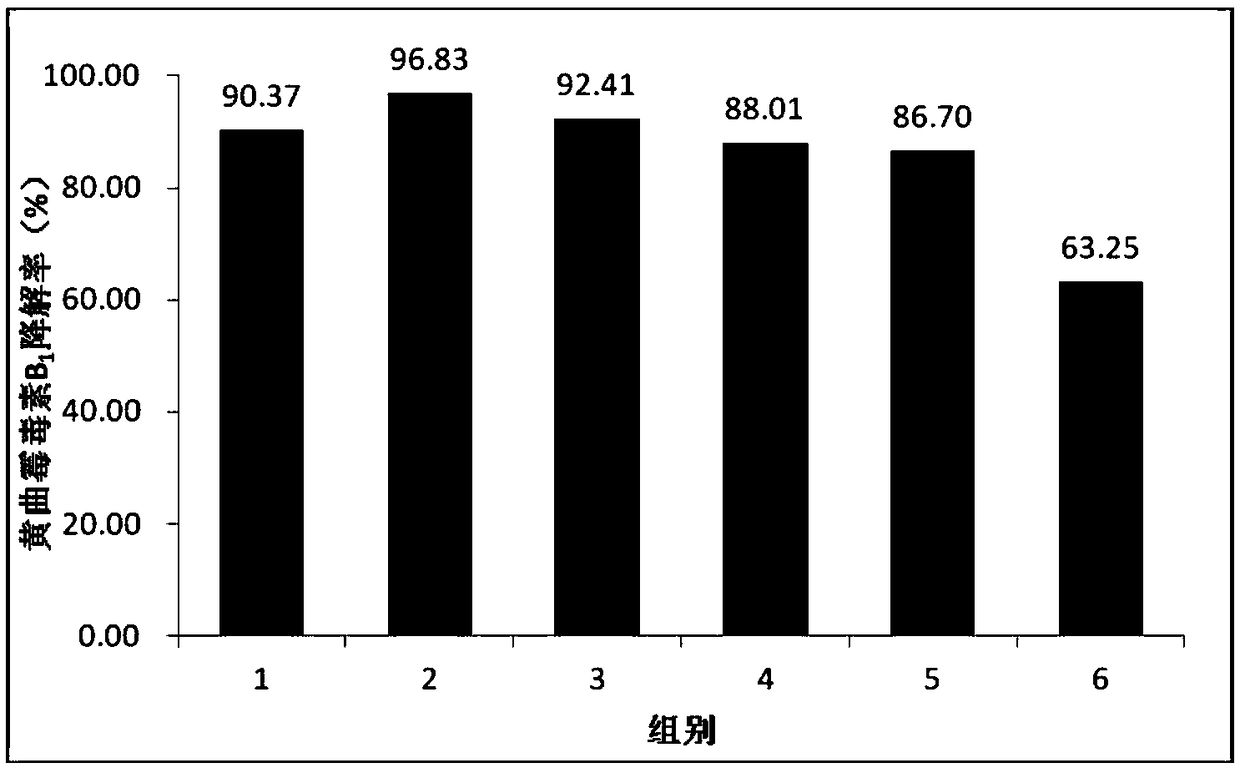Fermentation agent for degrading aflatoxin, and preparation method and application thereof
A kind of aflatoxin and fermentation agent technology, applied in the direction of microorganism-based methods, biochemical equipment and methods, microorganisms, etc., can solve the problems of incomplete detoxification, strict reaction conditions, uncontrollable degradation effect, etc., and improve intestinal tract Bacteria and microenvironment, enhance digestion and absorption function, improve the effect of bioavailability
- Summary
- Abstract
- Description
- Claims
- Application Information
AI Technical Summary
Problems solved by technology
Method used
Image
Examples
Embodiment 1
[0036] A fermenting agent for degrading aflatoxin is composed of a compound microbial bacterial agent and a synergist according to a weight-to-volume ratio of 4:1;
[0037] The composite microbial agent is formed by mixing Streptococcus thermophilus, Bifidobacterium, Candida utilis and Bacillus licheniformis according to the weight ratio of 1:1:3:3.
[0038] The synergist is prepared by mixing plant essential oils and auxiliary agents in a volume ratio of 1:0.3.
[0039] The plant essential oil is formed by mixing tea tree essential oil and cinnamon essential oil in a volume ratio of 1:1.
[0040] The auxiliary agent is prepared by mixing ethanol, Tween-80 and Span-80 in a volume ratio of 1:1:1.
Embodiment 2
[0042] A fermenting agent for degrading aflatoxin is composed of a compound microbial bacterial agent and a synergist according to a weight-to-volume ratio of 4:1;
[0043] The composite microbial bacterial agent is formed by mixing streptococcus thermophilus, bifidobacterium, candida utilis and bacillus licheniformis according to the weight ratio of 3:3:5:5.
[0044] The synergist is formed by mixing plant essential oils and auxiliary agents in a volume ratio of 1:0.3-0.5.
[0045] The plant essential oil is formed by mixing cinnamon essential oil and litsea cubeba oil in a volume ratio of 1:1.
[0046] The auxiliary agent is formed by mixing glycerol, Tween-80 and Span-80 in a volume ratio of 1:1:1.
Embodiment 3
[0048] A fermenting agent for degrading aflatoxin is composed of a compound microbial bacterial agent and a synergist according to a weight-to-volume ratio of 4:1;
[0049] The composite microbial bacterial agent is formed by mixing Streptococcus thermophilus, Bifidobacterium, Candida utilis and Bacillus licheniformis according to the weight ratio of 5:5:8:8.
[0050] The synergist is prepared by mixing plant essential oils and auxiliary agents in a volume ratio of 1:0.5.
[0051] The plant essential oil is formed by mixing eucalyptus oil and litsea cubeba oil in a volume ratio of 1:1.
[0052] The auxiliary agent is formed by mixing propanol, ethylene glycol, Tween-80 and Span-80 in a volume ratio of 1:1:1:1.
PUM
 Login to View More
Login to View More Abstract
Description
Claims
Application Information
 Login to View More
Login to View More - R&D
- Intellectual Property
- Life Sciences
- Materials
- Tech Scout
- Unparalleled Data Quality
- Higher Quality Content
- 60% Fewer Hallucinations
Browse by: Latest US Patents, China's latest patents, Technical Efficacy Thesaurus, Application Domain, Technology Topic, Popular Technical Reports.
© 2025 PatSnap. All rights reserved.Legal|Privacy policy|Modern Slavery Act Transparency Statement|Sitemap|About US| Contact US: help@patsnap.com



